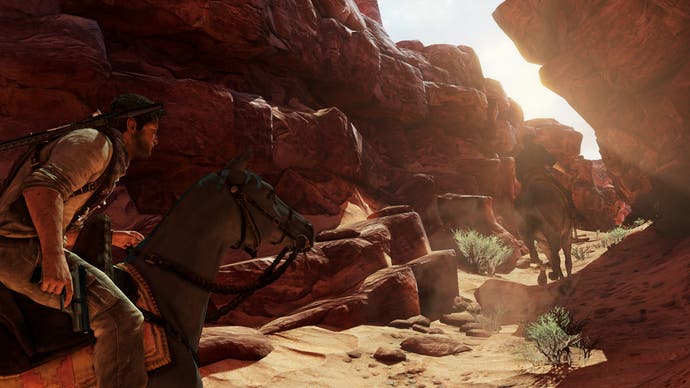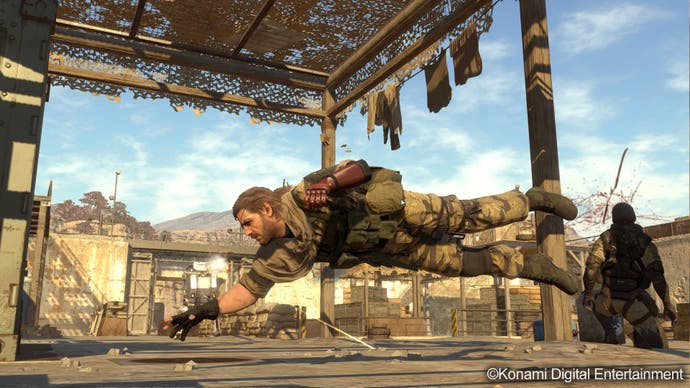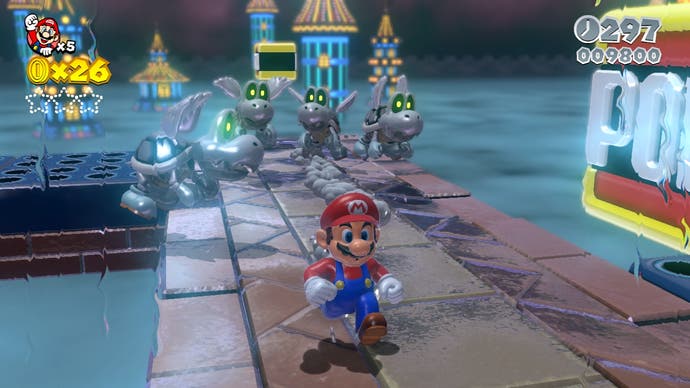Rich Stanton on: Other worlds and the inner eye
Why what we see is always what we think we see.
We have a certain imaginative sympathy with worlds we are invested in, and elevate them with subconscious complicity. Or to put it another way - the better the game, the more likely we are to give it a pass on below-par elements. No great revelation.
But where does that investment come from, and can it be designed for? I would argue that the prime factor behind it is a deeply interactive foundation. A specific example got me thinking on these lines. Monster Hunter 4 Ultimate, an absolute belter by the way, introduces the series first of destructible environments. I wasn't aware of this until, while standing on a bridge, a Rathian smashed through it and I pancaked from 50 feet. I was open-mouthed at this, stunned and thrilled in equal measure by this new factor in hunts.
As I got used to the collapsing bits of scenery, the basic animations and effects came to seem quite amusing - this is not physics-enabled destruction with pieces flying everywhere. The object will shake through a short animation cycle a few times, then 'collapse' into the ground in a giant puff of debris. It is not, by any objective marker, an amazing video game effect in a visual sense.

Yet its effect on me was intense - when that bridge went down the first time it was like an earthquake. There are several reasons why the effect is great beyond its basic appearance - the close camera, the walloping sound effects, the screen-shake - but by far the most important factor is how invested I am in Monster Hunter as an experience where what I choose to do matters.
A proposition: one part of fostering imaginative sympathy in a player is their identification with an avatar, a feeling of embodiment within the game's world. Games are predicated on interactivity and therefore the more actions an avatar is capable of performing, the greater their impact and presence within the game's world.
So in a game like Monster Hunter a collapsing column may not look impressive but, because the player feels so solidly connected to that environment, and because there are a range of outcomes based on the player's reactions, the cumulative effect of it can be stunning. When a bridge is collapsing you can stay there and get flattened, sprint to the edge and jump off, try to hop to another nearby platform, or even go full Hunter and launch a flying attack against the offending beast. The inherent flexibility of the mechanic, because it accommodates various responses from players, means it can also be re-used throughout the game with little loss of impact.
So if we have imaginative sympathy with a game like this, and are therefore more inclined to forgive or not even notice 'flaws' such as basic visuals, does that mean the opposite is also true?

A game type I always seem to have issues with are big-budget blockbusters that have some sort of association with the word 'cinematic.' Whether it's Heavy Rain or Uncharted my inner gawker wants to see them, but is never satisfied. Games like this are either dull or well-paced and forgettable. For the most part I find them deadening.
One of the appeals of an Uncharted or The Order: 1886 is visual spectacle - the sights, the set-pieces, the CGI! What is from one perspective a stunning technical achievement is probably also why I spend so long looking for flaws, and silently smirking at the various furniture arrangements cycled through to keep your progress funnelled.
In one of these 'cinematic' games a Monster Hunter-style visual effect would be a deal-breaker, because I am playing specifically to see those moments. This is not about comparing Monster Hunter and Uncharted like-for-like, because that's ludicrous, but rather considering how players are anchored into their worlds.
I am invested in the world of Monster Hunter, the fictional context, because the mechanics are so plentiful and work so well alongside it - and have enormous flexibility. In a typical third-person shooter, however, which is what most cinematic games end up as anyway, your investment in any given scenario is less. Your character will move in ways that are visually complex and dramatic, but have little interactivity or spatial complexity. Here the player's avatar is little more than a beautifully-animated dot moving from A to B, with temporary interactions like 'jumping' on climbable walls or QTEs /levers inserted to obscure the lack of agency. These sequences always have win states and fail states, but nothing in-between. As a player you inherently understand how limited your interaction is and passively play out the fireworks show. And because you don't really feel 'there,' you end up much less impressed with something technically impressive.
Apart from the simple pleasure of flipping the idea around - which games are we instinctively biased towards? - it also suggests something about the top-end trend towards 'better' graphics. This is a complex topic that's often reduced to black and white - graphics being nothing or everything, equally daft positions. But what if the sliding scale of visual impact is, in fact, much less dependent on technology than it is on interaction?

This brings us in a roundabout way to the zero-sum game many AAA publishers are playing. A lot of grousing has been done on their part about the recent step-up in consumer expectations and hardware, and the commensurately greater investment required to create such assets.
What is interesting about a game like The Order: 1886 is that, in this light, the game was designed in a mechanically unambitious manner and had an extremely short running time. In other words, the developers made the decision to background interactivity because people love sexy graphics. But such a decision, which undoubtedly has its theoretical basis in the 'blockbuster' phenomenon, means that in terms of video games The Order from day one of development could never deliver anything truly spectacular - a fully interactive (as opposed to tightly-controlled) set-piece. In favouring a purely visual approach of this nature, a game simply has to cramp possible interactions.
Consider also how this approach affects the very nature of interaction. Heavy Rain adopts a control scheme that tries to abstract in-game movements onto the analogue sticks and buttons - with extremely varying results. Most of the connections between your movements and the in-game action are arbitrary, which means their primary function soon becomes distraction. If you're just watching a cut-scene and making a choice every so often, you've a lot of time to pay attention to that nagging voice in the back of your mind saying "Quantic Dream make appalling games." But when you're constantly responding to prompts, idle thoughts have little time to flower.
My point here is not that these types of games shouldn't exist - there will always be a market for the 'best' visual experience available, and there are plenty of players willing to trade elements of interactivity for that. Games are a broad church and the AAA cinematic experience, gigantic red herring though it is, will always be in attendance. I find it more interesting that visual fidelity is much less important to the user experience than visual artistry - the combination of world-building, non-visual effects, and suggestion that allows developers to 'get away' with shortcuts. And that by extrapolating from this we come to some pretty damning conclusions about design at the sharp end.
Consider the nature of player choice, which is often discussed in purely narrative terms. One of my more unpopular opinions is that both Bethesda Game Studios and BioWare are B-list studios. Their games are often good enough, but the very things people praise - the exploration, the world-building, the choices - are not at all what I value in them. 'Choices' in BioWare games always leave me cold - I don't care because every potential choice is so tightly-controlled, and I know with absolute certainty the game's forward momentum will continue regardless.
Why do these choices feel empty? Think about how the news always ends with brief reports on the Dow Jones - something that personally bores me to tears. But others care. There's a great phrase on Wall Street, which I learned from suited analyst Chris Donlan, which says people who are invested have a position in the market, so they care whether it goes up or down. If you don't have a position, you don't care.
Now think about the kind of intense control that AAA games often exert over the player and your narrative 'choices'. Do you, when playing Dragon Age, have a position in the market? Are you invested? I've started to feel that almost none of these games offer deep enough systems to invest me in their world, so when they then try to floor me with a Meaningful Decision I couldn't give a toss and go with my mood.

Something like Monster Hunter, on the other hand, or Dark Souls or - to take an extreme example - Spelunky? I'm invested in that. I have a position in the market, and so how to tackle a environmental hurdle or a rampaging Deviljho is a much more meaningful decision to me - even though a 'choice' dialogue box never once appears on-screen. I genuinely spend more time thinking about what to buy in Spelunky's shop than I have ever spent considering a choice in a BioWare game.
I put it to you that narrative choice is nothing more than an illusion, and one that doesn't matter anyway - to me, the choices that matter are the ones that depend on the game's systems. Let's take this further and consider how, in talking about games, we often think about and describe the techniques used in a literal way: the techy stuff, 4k and 200FPS or bust, and then the size of environments or the playing time and so on.
This latter way of looking at games has become increasingly alien to me. I value stuff like high framerate and resolutions, of course, but find tech pedants unbearable. Games are technological productions, and we shouldn't lose sight of that, but in a world where technology is no longer as restrictive as even 10 years ago this is increasingly the least interesting thing about them.
What I value above anything is deep systems, interactivity that goes far beyond the slick Simon Says of a Naughty Dog production. It is no accident that deep systems nearly always go hand-in-hand with excellent games, and this is because an interactive foundation elevates every other aspect of a video game's production. If you feel you're in that world, then you have a position in the market - and smarter devs can start using that in their designs, as some already do.
This is not a call for more experiential writing about how Half-Life 2 saved my melon farm. It is more a poser about how we engage with and discuss something we can see and hear, but only fully understand when we're in control. If what we as players prize is interactivity, then perhaps it's time to move away from asking what a particular game can do. And start questioning what we can do with the game.

